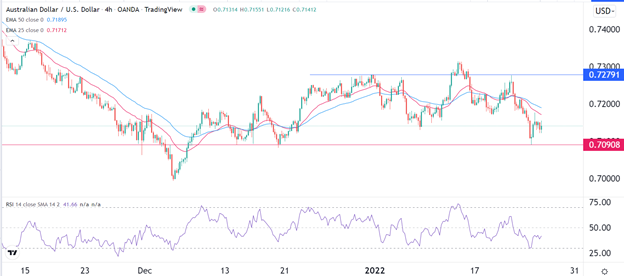Bearish View
- Sell the AUD/USD pair and set a take-profit at 0.7090.
- Add a stop-loss at 0.7200.
- Timeline: 1-2 days.
Bullish View
- Set a buy-stop at 0.7150 and a take-profit at 0.7200.
- Add a stop-loss at 0.7100.
The AUD/USD pair tilted lower in the morning as investors reacted to the strong Australian Consumer Price Index (CPI). The pair also declined after the latest American confidence data and the upcoming interest rate decision by the Federal Reserve. It is trading at 0.7140, which is about 2.45% below the highest level this year.
RBA Tightening?
The AUD/USD pair declined slightly even after the relatively strong Australian inflation data. According to the Australia Statistics Bureau (ABS), the country’s inflation rose from 0.8% in the third quarter to 1.3% in Q4. That increase was better than the median estimate of 1.0%. On a year-on-year basis, inflation rose from 3.0% to 3.5% in the same period.
Other inflation indicators also rose in Q4 as energy prices rose and the supply chain challenges remained. For example, the weighted mean CPI increased from 2.2% to 2.7% while the trimmed-mean CPI increased from 2.1% to 2.6%.
These numbers were higher than the target of the Reserve Bank of Australia (RBA) of 2.0%. Therefore, analysts expect that the RBA will start tightening in its first meeting of the year that will take place in February. Precisely, analysts expect that the RBA will end or taper its asset purchases in February and then hike interest rates in the second or third quarter of the year.
The AUD/USD pair also declined after the latest US consumer confidence data. The numbers showed that confidence dropped to about 113.5 in January. This decline was better than the median estimate of about 111.50.
Therefore, with the economy doing well, there is a likelihood that the Fed will hint about further tightening. It will leave its interest rates unchanged and point to making the first hike in March this year.
AUD/USD Forecast
The four-hour chart shows that the AUD/USD pair has been under intense pressure in the past few weeks. It has moved to about 0.7140, which is below the 25-day and 50-day exponential moving averages (EMA). It has also formed a head and shoulders pattern, which is usually a bearish signal. The Relative Strength Index (RSI) has been in a downward trend.
Therefore, the pair will likely continue falling as bears target the next key support level at 0.7090, which was the lowest level this week.

